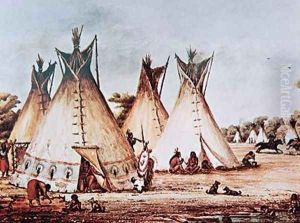Baldwin Mollhausen Paintings
Baldwin Heinrich Wilhelm Mollhausen, born on January 27, 1825, in Bonn, Germany, was a multifaceted individual known primarily for his contributions as an explorer, artist, and writer. Mollhausen's early life in Germany offered little hint of the adventurous path his career would later take. He initially embarked on a career in the arts, but his restless spirit soon led him to the United States, marking the beginning of his life's most defining adventures.
In the early 1850s, Mollhausen found himself involved in expeditions that would map the American West. He served as a topographer and artist for the North Pacific Railroad Survey (1853-1854) under the command of Isaac Stevens and later joined the expeditions of Lt. Amiel Weeks Whipple while surveying a route along the 35th parallel for the Pacific Railroad. His detailed sketches and watercolors from these expeditions provided invaluable insights into the landscape and native peoples of the region, contributing significantly to the understanding of the American frontier.
Mollhausen's experiences in the American West deeply influenced his later work. Upon returning to Germany, he began a successful career as a writer, drawing upon his adventures and observations in the United States. His novels and travel accounts, filled with vivid descriptions of the American landscape and its inhabitants, enjoyed popularity in both Europe and America. Through his writings, Mollhausen offered his readers insights into the challenges of exploration and the beauty of the uncharted territories of the American West.
Mollhausen's contributions were not limited to his artistic renderings and written accounts. His interactions with Native American tribes and observations of the natural environment provided valuable ethnographic and scientific data, contributing to the broader understanding of these areas during a period of significant change and expansion in the United States. Baldwin Mollhausen passed away on May 28, 1905, leaving behind a legacy as one of the most insightful and multifaceted observers of the American West during the mid-nineteenth century. His works continue to be studied for their artistic, historical, and ethnographic value, offering a window into a pivotal era in American history.
